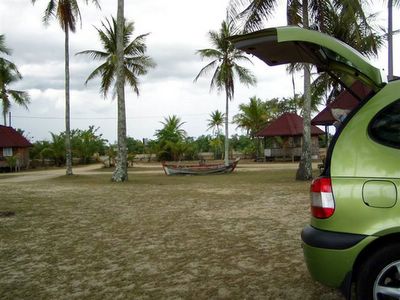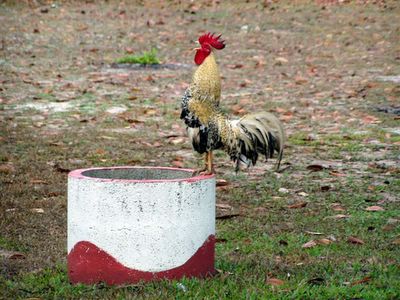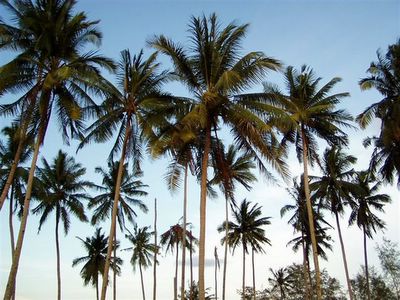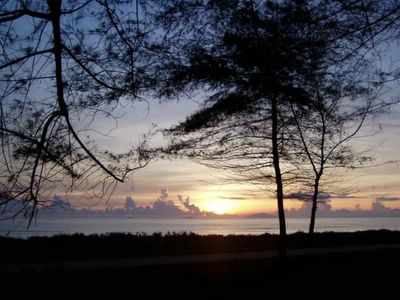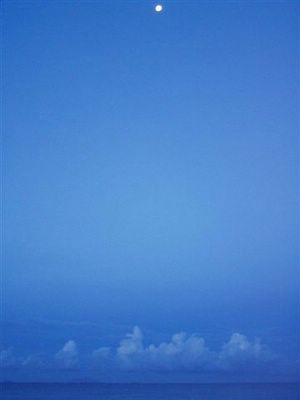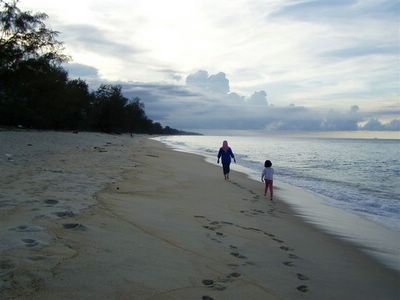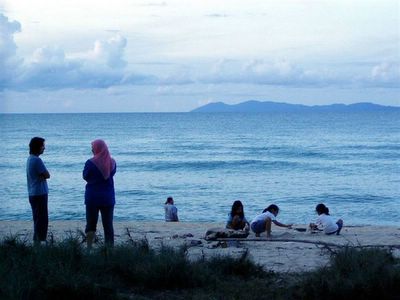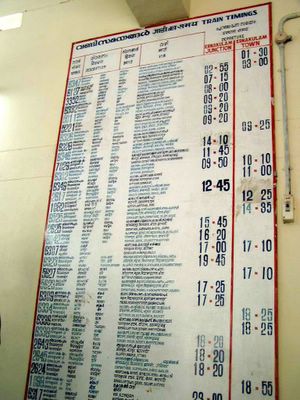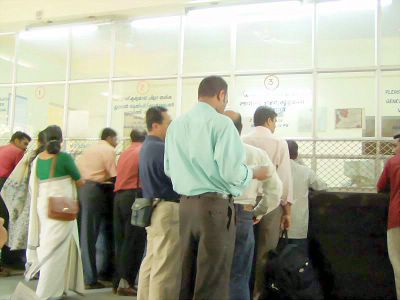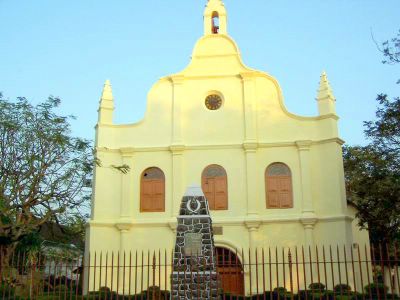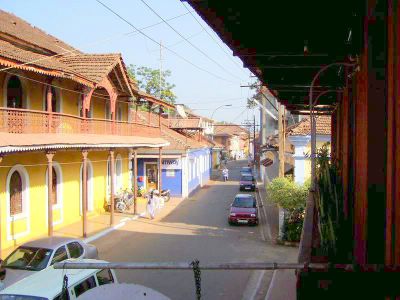Penarik, a very scenic village on the East Coast of Peninsular Malaysia. Home to fishermen who ekk their daily living by fishing the coastal waters.
And this is Penarik Inn, a collection of traditional chalets run by amiable Mr Baharuddin and his wife Kak Ana (Tel: +60 13 3260564), which faces the South China Sea. On the other side of the chalets runs the brackish Setiu River, home to fish, terrapins, shellfish and other aquatic critters. Mangroves line the other side of the river, providing a rich spawning ground.
A pleasant spot to unwind and watch the clouds roll by.
Wednesday, May 05, 2004
Tuesday, February 10, 2004
FIRST ~ India 020204a: Chinese Fishing Net at Fort Cochin, Kerala
A major tourist attraction at Cochin are the Chinese fishing nets, thought to be introduced there by traders from the court of Kublai Khan. Pic attached shows some of the big ones found at Fort Cochin, still in working condition, though the fish caught are prolly only good enough for the waiting crows. I even saw these contraptions along rivers during our train ride to Goa. Cannot be found elsewhere in India.
India 020204b: Train Schedule
Trains are the lifeblood of the Indian society. Air travel being still beyond the reach of most common folks, while roads and traffic not being user-friendly for long-distance driving, trains remain as popular as ever. Families routinely take 40-50-hr train rides to visit relatives on the other side of the country.
The pic attached is the express train schedule at Ernakulam Town station, a major stop outside Cochin. When I first looked at table, it was confusing and unnecessarily complicated (but then that's what Indians are famous for - making simple things complicated!) - 3 scripts were used, English, Hindi, Malayalam.
We decided to take train #2617, impressively named the 'Mangala-Lakshadweep Express', departing at 12.45pm (seen a third of the way down the table), for our 15-hr trip to Goa up north. We later found out the train went all the way to a place called Nizamuddin, a major station in New Delhi. Total traveling time to Delhi: 60 hours! :-)
Buying the train tickets is another lengthy process in itself, but I'll leave that for the next time.
India 020204c: Buying train tickets
Purchasing a train ticket in India is quite an experience (pic). First you have to find a little form (with English version overleaf) to fill up your ticket requirements and your personal details such as name, age (?) and address. Then go to the counter and queue for your turn. I spent quite some time at the counter because my first choice train was out of special 1st class seats. We had to settle for another express with a normal first class seat, leaving at 12.45pm 3/2, for Goa enroute to Delhi. We paid about 1,700 rupees (RM150) for 2 tickets. The lady at the counter was helpful and chased away the occasional queue jumpers who barged in. :-)
India 020204d: St Francis Church in Fort Cochin
This is the St Francis Church, the first European Church to be built in India, and is located at Fort Cochin, the first European settlement in India. Built in 1503 by the Portuguese (first led by Alphonso d'Alburquerque), just 5 years after Vasco da Gama became the first European to discover the sea route to India when he landed in Calicut 1498. BTW, da Gama first visited Fort Cochin in 1502, and during another visit there in 1524, he died and was buried in this church. 14 yrs later, his body was removed to Portugal.
There you go, all the big time Portuguese jokers were there, but enough of history lesson! The church faces the beach, some 300m away, where the Chinese fishing nets are. Nice ambience especially in late afternoon, with houses and playing fields (incl a cricket pitch). With the low sun beating on its bright facade, for a moment I thought I was staring at a church in a Zorro movie. :-)
--------------------
St Francis Church
Built in the year 1503
1503 to 1663 - Portugese Period (Roman Catholic Church)
1664 to 1804 - Dutch Period (Dutch Reformed Church)
1804 to 1947 - British Period (Anglican Church)
1947 onwards - Church of South India
1503 to 1663 - Portugese Period (Roman Catholic Church)
1664 to 1804 - Dutch Period (Dutch Reformed Church)
1804 to 1947 - British Period (Anglican Church)
1947 onwards - Church of South India
India 040204a: Panjim Goa - Old Portuguese Houses
So we caught this long express train at Cochin Junction station, leaving at 12.45pm sharp, 3/2, to arrive Goa 4am the next day.
[The Indian train system uses the broad gauge 5' 6" (cf. Europe/US & Malaysia LRTs use standard gauge 4' 8.5", Malaysia KTMB uses 3' 3" gauge). It has the 4th largest railway system in the world and employs 1.6mil ppl, the biggest employer in the world. The wide gauge allows for huge coaches and smooth comfy rides, which was what we got in the Cochin-Goa stretch. We also got an Indian creep who tried to harass a German girl next to us, but he was thrown out by the ticket inspector at the next station which happened to be the famous city of Calicut :-). ]
Early morning accommodation hunting got us a very cosy 2-floor 150-yr-old inn called the Panjim Inn, located in the old Latin Fontainhas quarter of Panjim, the capital of Goa. Cost us 1,500 rupees (RM130) for one night, a bit pricey, but we had real antique furniture around us - very old wooden bed, looked flimsy but tough! Checked in at 5am and was soon fast asleep!
The pic attached is taken during breakfast on 4/2, from the verandah cafe upstairs. It shows the original Portuguese houses built hundreds of years ago since Fontainhas is the oldest quarter in Panjim.
India 040204b: Panjim Goa - Malacca Street
Having had a late breakfast at Panjim Inn, we were ready to explore the place. The town map in our travel book showed a familiar name: Malacca Street! The thing about Goa is that they still preserve the old names (streets, landmarks, quarters, etc) given by their Portuguese colonists, and Malacca Street was obviously our first destination. :-)
We trudged along narrow streets flanked by brightly-coloured Latin European style houses as we passed the ancient Fontainhas quarter. The town centre proper was a typical modern Indian town - straight roads with shophouses. There was a very conspicuous white church on a hill in the town centre, built by the Portuguese for their sailors/soldiers, who had endured months of ocean travel, to come ashore to say thanks to the Lord as soon as they arrived from Lisbon (what a trip that must have been!). They then travelled another 10 km to the east, upstream the majestic Mondavi River, to their barracks at Old Goa (the old capital till the 1840s).
Pic shows the spot where Malacca Street starts, flanked by the orangish state library building and police HQ to the right, and shophouses to the left. The structure in the middle of the junction is the traffic policeman's shelter. The Mondavi River is right behind me, where there is an esplanade giving scenic vistas of the river.
India 040204c: Panjim Goa - Mandovi River
This is the grand Mondavi River viewed from the esplanade at Panjim. 2km to the left you reach the river mouth and the Arabian Sea, 9km to the right gets you to Old Goa, seat of the Portuguese govt until 1843. It was said to rival Lisbon in splendour during its hey-days, when epidemics, among others, drove the population to Panjim, the new capital.
The Mandovi River between Panjim and Old Goa is home to countless egrets, herons and other water-birds, big and small. Most likely because the river is teeming with fish, which is fair since the water looked clean and unpolluted. Tourist cruise boats roamed the waterways, but we gave it a pass and instead hired a taxi for a trip to Old Goa.


